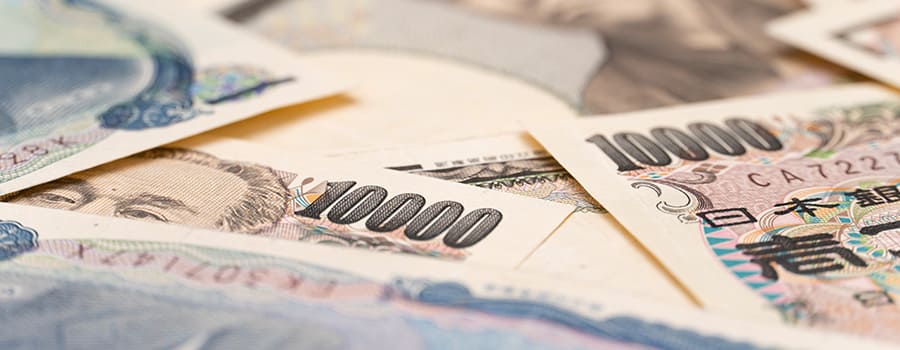You have heard of the G7, but you don't quite know how it relates to the issue of currencies? Take five minutes to read all about the most influential world forum and its impact on the most traded currencies on the foreign exchange market.
The G7 currencies (“G7” coming quite simply from “group of seven”) are the currencies of the world’s most important economies and include five of the most important currencies in the world, being both the most traded and the most liquid on the foreign exchange market. These currencies are made up of the US dollar (USD), the euro (EUR), the Japanese yen (JPY), the British pound sterling (GBP), and the Canadian dollar (CAD).
The G7 is a forum bringing together the world’s most influential and industrialised countries. Founded with the aim of sharing macroeconomic initiatives, the forum has significant international influence and is at the centre of major global initiatives. Initially, the G7 was formed in 1975 as the G6 upon the initiative of the then German and French heads of State in the wake of the collapse of the Bretton-Woods system, the 1970s energy crisis, and the related global recession. The last country to join the forum was Canada and the group decided to continue meeting annually since then. The countries that form the G7 include Canada, France, Germany, Italy, Japan, the United Kingdom and the United States and their five corresponding currencies: the Canadian dollar (CAD), the euro (EUR), the Japanese yen (JPY), the British pound (GBP) and the American dollar (USD). According to the International Monetary Fund (IMF), each of the five currencies belonging to G7 countries are reserve currencies, or “anchor currencies”, held by central banks around the world. As the combination of these countries represents 40% of the world’s GDP, keeping a close watch on developments in the economies of the G7 currencies and especially the 5 respective currencies is important for anyone impacted by international trade and the foreign exchange market.
But what makes these five currencies so special? Why are they granted such importance?
What makes the G7 currencies so strong?
Countries or currency areas with a particularly liquid currency usually share a number of characteristics:
- Considerable economic clout
- Sustained growth
- A robust financial and banking system
- Confirmed political stability
To better understand the dominance of these five currencies, let's take a closer look at them.
The US dollar (USD)
To the question “What is the most important currency in the world?” there is only one obvious answer: the US dollar. As a result, it is considered by far to be the world’s most important reserve currency.
According to the IMF, more than 60% of the world's foreign currency reserves are denominated in US dollars. 40% of the world's debt is also denominated in dollars.
But has this always been the case?
The dollar in the 20th century
Between the 1940s and the 1970s, the US dollar was the standard around which the exchange rates of the world's major currencies fluctuated. The Bretton Woods Agreement of 1944 reaffirmed the dollar’s dominance as the benchmark currency, due to its convertibility into gold.
In accordance with the fixed exchange rate system resulting from these agreements, 44 countries pegged their currencies to the dollar, with a certain fluctuation band around the dollar being authorised.
However, the economic upheavals of the 1970s forced the US to devalue its currency and the dollar’s convertibility into gold was no longer justified. Under these circumstances, the floating (or flexible) exchange rate regime became widespread.
But what about the dollar today?
The dollar in the 21st century
Today, most currencies fluctuate freely according to market movements and are no longer pegged to the dollar.
However, the dollar remains the world’s most important currency, this being partially due to the importance of the US economy internationally and the dominance of US financial markets.
Despite a considerable budget deficit and high levels of foreign debt, the financial and banking world firmly believes in the ability of the US to pay back its debts. This makes the dollar the most tradeable currency on the foreign exchange market and a safe haven for market players.
The US central bank, the Federal Reserve (Fed), sets out and executes the country's monetary policy.
|
Did you know? The dollar is also the benchmark currency for the global commodity market, owing to its stability as a means of exchange. When the dollar’s value decreases, the cost of commodities becomes higher in dollars and lower in foreign currencies. Commodities therefore become cheaper when the dollar is weak, and more expensive when the dollar is strong. |
The euro (EUR)
Introduced in 1999, the single currency entered into circulation in 12 initial European countries as of 2002. The countries that have adopted the euro are part of a monetary zone commonly referred to as the eurozone. While it has since been adopted by a total of 19 European countries, Central Europe is still home to countries that still have their own currencies.
The euro is the second most traded currency on the foreign exchange market after the dollar, but came into existence only very recently.
Brief history of the euro
A long-standing ambition of the European Economic Community (EEC), monetary union finally started to gain traction at the European summit held in Brussels in 1978. The European Monetary System (EMS) and the Exchange Rate Mechanism (ERM) were then established. The latter provided for fixed, but adjustable, exchange rates applied to all national currencies within the bloc. With the launch of the Single Market Programme in 1985, the process of streamlining and planning for convergence began to gain momentum.
Once the Maastricht Treaty was signed in 1992, the process of Economic and Monetary Union (EMU) began:
- 1991-1993
Progressive authorisation of the free movement of capital. - 1993-1998
Gradual convergence of economic policies among countries within the bloc. - 1999-2002
Introduction of strict budgetary rules and development of a common monetary policy.
Since the euro began circulating in 2002, the European Central Bank (ECB) has been responsible for its issuance. As the only central bank in the world responsible for the monetary policy of several countries, the ECB is a unique institution. It is responsible for guaranteeing the value of the euro as a currency, and ensuring price stability in the eurozone.
But is the euro considered a safe haven?
The euro 20 years on
According to the IMF, the euro accounts for about 20% of the world's foreign currency reserves.
However, unlike the US dollar, the single currency is not considered a safe haven, though it shares some essential characteristics:
- The debt of all eurozone countries amounted to 78% of the currency area’s GDP in 2019, a percentage lower than that of the United States or indeed Japan.
- The eurozone tends to maintain a current account surplus.
- 33% of transactions carried out worldwide involve the euro.
However, political conditions sometimes perceived as unstable mean that the euro is not considered a safe haven currency. In times of crisis, these conditions tend not to reassure market players.
The political divergences and structural shortcomings of some eurozone countries sometimes give rise to fears regarding the currency’s strength and stability.
A political rapprochement between member countries could bolster the euro and elevate it to the status of safe haven, but this seems a distant prospect for now, as economic models across the bloc differ considerably.
|
Did you know? At the European summit in The Hague in 1968, the project of monetary union within the EEC was discussed, but these talks did not lead to any concrete proposals. The economic crises of the 1970s, marked by serial devaluations and the end of the fixed exchange rate regime, made the prospect of a common currency impossible in the immediate term. |
The Japanese yen (JPY)
The yen is the third most traded currency on the foreign exchange market. Although it may come as a surprise if one is not familiar with all things forex, the yen is considered a safe haven just like the dollar.
Although the country has been grappling with a number of economic difficulties since the 1990s, Japan remained the world's third largest economy in terms of GDP in 2019, and is still one of the world's biggest exporters.
But why does its currency maintain a privileged status?
The yen, a young currency in an elderly country
While Japan is known for its ageing population, the country's currency is relatively young, and has been in circulation only since 1871.
Prior to this period, Japan did not have a single currency for the whole country. Driven by the government of the Emperor Meiji, the introduction of a national currency was part of a rapid industrialisation process undertaken in the 19th century.
The absence of a banking system comparable to that of western countries limited Japan's economic power at international level. The Bank of Japan (BoJ) was therefore founded in 1882 to implement and execute the country's monetary policy.
So, why is the yen so important today?
The yen in modern times
Although Japan enjoys considerable economic clout and political stability, its economic performance has presented some noticeable weaknesses since the 1990s.
Since the bursting of the real estate bubble and the resulting financial crisis, the country has been marked by:
- Low year-on-year growth (rarely exceeding 2%).
- A recurring deflation problem.
- Very high public debt (the largest in the world relative to GDP).
However, this does not seem to be a source of worry for foreign exchange market participants, with the yen retaining its status as a safe haven.
The yen’s favourable perception is primarily due to two major factors:
- Japan’s considerable trade surpluses, with the country remaining a specialist in a number of high-tech exports, from automobiles to new technologies.
- Japan is the world's third largest economy in terms of GDP, behind the United States and China.
A key indicator of the yen’s global importance, the Japanese currency tends to appreciate in times of uncertainty. This phenomenon was particularly noticeable in 2010 when the eurozone crisis triggered a 10% increase in its value against the euro. Moreover, in July 2020, when the dollar continued its decline due to concerns about US management of the Covid-19 crisis, as well as persistent tensions between Washington and Beijing, the value of the yen rose considerably.
|
Did you know? Japan has the lowest birth rate of any developed country, with a fertility rate of just 1.4 in 2019. At the current rate, the percentage of the Japanese population aged over 65 will increase from 26% today to 45% in 2050. The shrinking tax base and the likely ballooning of welfare costs could have serious consequences for the Japanese economy in the long term. |
The Great British pound
As the fourth most traded currency on the foreign exchange market and the third most held currency reserve in the world, the Great British pound ranks firmly among the most important currencies on the forex. Its important role on the global scene is partly due to the capital’s status as a financial trading hub and its long history of global leadership.
Despite the fact that the United Kingdom did not adopt the euro and opted to keep its own currency, parallels can be drawn between the two:
- The European Union is the United Kingdom’s main trade partner.
- The pound and the euro fluctuate against one another and tend to remain in a narrow range.
- The Brexit referendum has recently been a key factor influencing the currency’s volatility and its value against other leading currencies.
The Great British pound is popular among forex traders for several reasons. The main sectors contributing to the British economy are the aerospace, pharmaceutical and automotive industries as well as the service sector. Its financial services industry in particular plays a major role: it represents the country’s largest exporting industry, the country’s largest tax-paying sector and one of the biggest employers in the country. Additionally, London counts among the world’s largest and busiest trading centres; a factor that contributes to the high amount of trade in this currency. Since Brexit however, the importance of the pound in the UK’s exports has been falling in favour of the dollar, and directly affecting the competitiveness of UK exporters.
|
Did you know? The coins also feature the profile of the monarch in power and the direction in which the monarch faces alternates with each successive monarch, a tradition that first started in the 17th century. The abdication of Edward VIII was the only time the pattern was broken. The coins minted when he ascended the throne featured his left profile, because he thought his left side was better than his right. However, they were not put in circulation before his abdication less than a year after he ascended the throne. His brother George VI decided to have his left profile also feature on the coins when he took power, as if his predecessor’s coins had faced right as they should have according to tradition. |
The Canadian dollar
Canada’s economy relies heavily on its commodity exports, especially energy and natural resources such as wood, oil and gas. As a result, its currency is considered a commodity-based currency. While they tend to be more prevalent among developing countries, Canada along with other more developed countries like Norway are an exception.
A 2009 study demonstrated that exchange rates of commodity currencies can help predict future commodity prices.
Having a currency tied to commodities has both positive and negative effects:
- Demand for a country’s commodity naturally strengthens the national currency’s value and equally contributes to increasing the country’s GDP. The exports related to the strong external demand however lead to an increase in price and a subsequent risk of inflation/
- Conversely, a decrease in demand can lead to deflation and decrease the country’s GDP.
Because of its close proximity with the United States, the Canadian currency is also strongly influenced by its neighbour’s currency, and the country’s reliance on the state of the US economy is significant.
|
Did you know? Canada and its commodity-based currency are particularly vulnerable to the Dutch disease. What is the Dutch disease? Coined in the 1970s to describe the fall of the Dutch manufacturing sector to the expense of the discovery of a gas field, the term describes the causal relationship between the increase in revenues from a given sector and its negative impact on the nation’s other sectors. As a sector develops and generates demand it increases the currency’s value which results in the nation’s other exports to become more expensive and less competitive. The Canadian currency’s strong tie to commodities makes it particularly prone to catching the Dutch disease. |
The importance of a currency on the foreign exchange market is dependent on numerous factors, ranging from a country or currency area’s economic strength to their political stability. Beyond these factors, there are also a number of economic indicators within a country that contribute to establishing a currency’s importance on the foreign exchange market
The US economy is the most powerful in the world, and the dollar, by far the most important international reserve currency, is considered a safe haven. The euro is the second most traded currency in the world and accounts for 20% of the world's foreign currency reserves. Despite the region’s undeniable economic importance, not to mention its frequent current account surplus, the eurozone is sometimes weakened by political uncertainty, and the deficiencies of certain member countries are a cause for concern in times of crisis. While it is not considered a safe haven currency, it is becoming a strong contender. The same cannot be said of the Great British pound that undergoes periods of considerable volatility The national currency of the world's third largest economy, the yen, is propped up by Japan's impressive trade surpluses and its value tends to appreciate in times of crisis, conferring it the status of safe haven currency.
As the strongest currencies in the world, these currencies are also the most traded on the foreign exchange market. Nonetheless, the world of forex is constantly changing. Previously overlooked currencies, especially in Asia, are beginning to gain traction and attract the attention of the foreign exchange market. To gain a better understanding of them, read our article on emerging currencies in Asia.
Topics






